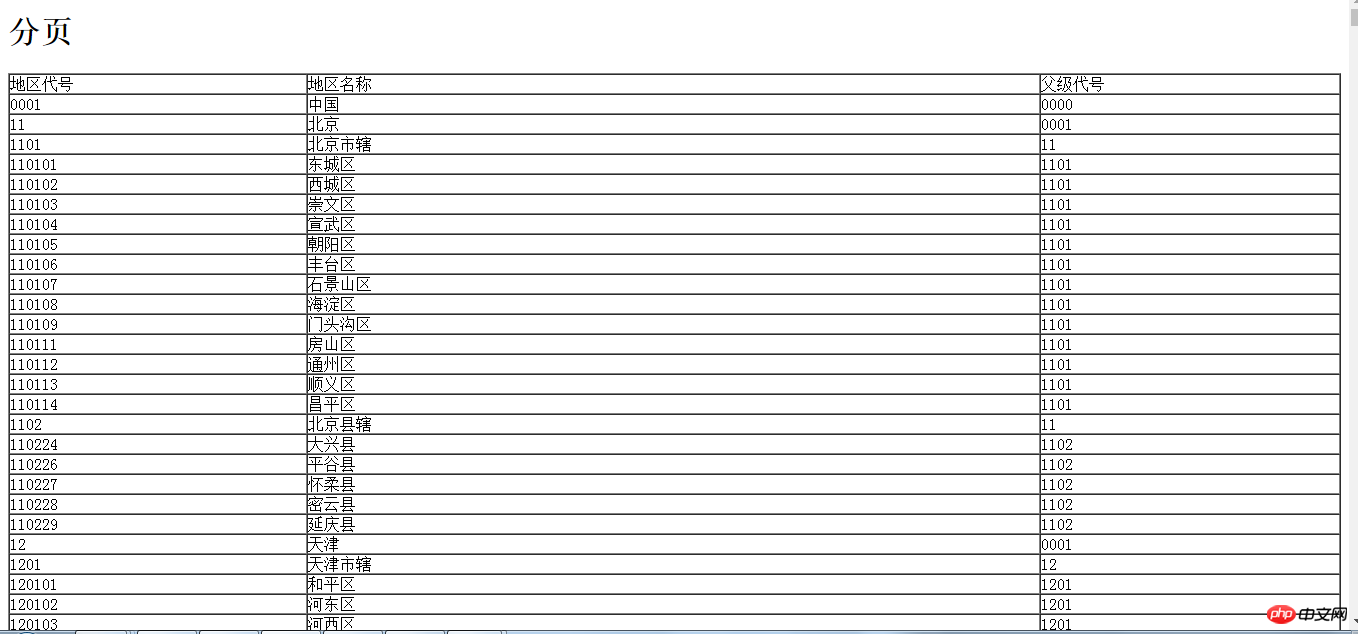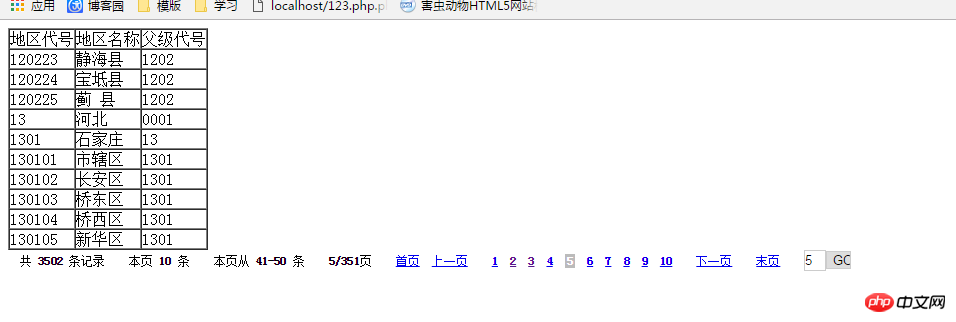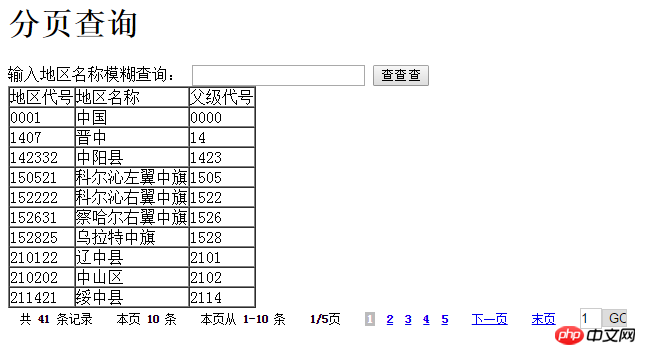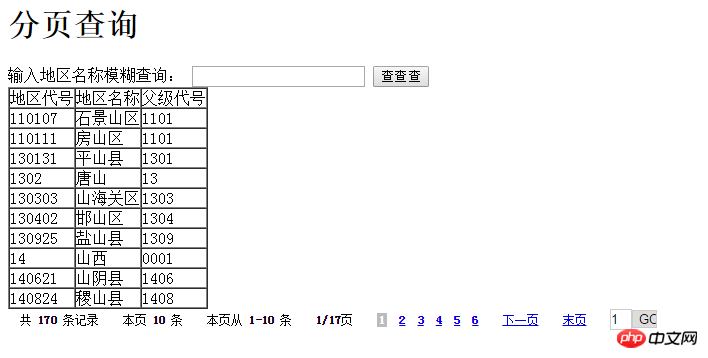php分页查询 - 附php分页代码
php分页查询通过引用page.class.php分页工具,就好写多了;
以下就是php分页代码
1.首先要有显示的内容:
<!DOCTYPE html PUBLIC "-//W3C//DTD XHTML 1.0 Transitional//EN" "http://www.w3.org/TR/xhtml1/DTD/xhtml1-transitional.dtd"> <html xmlns="http://www.w3.org/1999/xhtml"> <head> <meta http-equiv="Content-Type" content="text/html; charset=utf-8" /> <title>无标题文档</title> </head> <body> <h1>分页</h1> <table width="100%" border="1" cellpadding="0" cellspacing="0"> <tr> <td>地区代号</td> <td>地区名称</td> <td>父级代号</td> </tr>
<?php
include ("db.class.php");
$db = new db();
$sql = "select * from chinastates ";
$arr = $db->Query($sql);//默认=1可以不写
foreach($arr as $v)
{
echo "<tr>
<td>{$v[0]}</td>
<td>{$v[1]}</td>
<td>{$v[2]}</td>
</tr>";
}
?>
</table> </body>
图:

2.引用page.class.php分页工具造对象,把总数查出来吧:
include ("page.class.php");
//查总条数
$sz = "select count(*) from chinastates";
$az = $db->Query($sz);
//1.造对象
$page = new page($az[0][0],10);
//一般只写两个参数,第一个数据的总条数
//取两个索引0:先取索引0二维数组,取到一位数组后取索引0
//第二个参数,显示10条
$sql = "select * from chinastates ".$page->limit;
//2.直接在sql语句后面拼接上$page(分页类)里面的limit,就可以完成分页
$arr = $db->Query($sql);//默认=1可以不写
3.输出:
<?php //3.输出分页信息 echo $page->fpage(); //分页对象中的fpage()方法 ?>
总代码:
<!DOCTYPE html PUBLIC "-//W3C//DTD XHTML 1.0 Transitional//EN" "http://www.w3.org/TR/xhtml1/DTD/xhtml1-transitional.dtd">
<html xmlns="http://www.w3.org/1999/xhtml">
<head>
<title>无标题文档</title>
</head>
<body>
<h1>分页查询</h1>
<table border="1" cellpadding="0" cellspacing="0">
<tr>
<td>地区代号</td>
<td>地区名称</td>
<td>父级代号</td>
</tr>
<?php
include ("DBDA.class.php");
//引用封装类
$db = new db();
//造对象
include "page.class.php";
//引用page工具
$aall = "select count(*) from chinastates";
//查询所有数据
$arr = $db->Query($aall);
//调用sql,返回一个数组,
$page = new page($arr[0][0],10);
//page类对象,每页显示10条
$sql = "select * from chinastates ".$page->limit;
//分页查询,page类调用limit
$ar = $db->Query($sql);
//执行,并返回一个数组(数据)
foreach ($ar as $v)
//遍历
{
echo" <tr>
<td>{$v[0]}</td>
<td>{$v[1]}</td>
<td>{$v[2]}</td>
</tr>
";
}
//显示
?>
</table>
<p>
<?php
echo $page->fpage();
//直接输出page类里面的fpage()(输出分页信息)
?>
</p>
</body>
</html>
最后的完成图:

4.分页查询
查询关键字,在本页分页显示!
首先form表单:
<form action="fenyechaxun.php" method="get"> //提交给当前页面,用get传递 <p> 输入地区名称模糊查询: <input type="text" name="area"/> <input type="submit" value="查查查"/> </p> </form>
分页查询的条件
$tj = "1 = 1 ";
//条件恒变量
if(!empty($_GET["area"]))
//判断传过来的是否非空
{
$r = $_GET["area"];
//为了防止双引号有冲突,给变量
$tj = "areaname like '%{$r}%' ";
//条件改变
}
查询语句也需要改变一下:
$aall = "select count(*) from chinastates WHERE {$tj}";
//查询所有数据
$sql = "select * from chinastates WHERE {$tj} ".$page->limit;
//分页查询,page类调用limit输出:
<p>
<?php
echo $page->fpage();
//直接输出page类里面的fpage()(输出分页信息)
?>
</p>
上图:

查询的数据也是以分页的形式:

代码:
分页查询
| 地区代号 | 地区名称 | 父级代号 |
| {$v[0]} | {$v[1]} | {$v[2]} |
echo $page->fpage();
//直接输出page类里面的fpage()(输出分页信息)
?>
page.class.php分页工具
/**
file: page.class.php
完美分页类 Page
*/
class Page {
private $total; //数据表中总记录数
private $listRows; //每页显示行数
private $limit; //SQL语句使用limit从句,限制获取记录个数,查数据要查哪几条;limit(0,10)跳过第0条,取10条
private $uri; //自动获取url的请求地址
private $pageNum; //总页数
private $page; //当前页
private $config = array(
'head' => "条记录",
'prev' => "上一页",
'next' => "下一页",
'first'=> "首页",
'last' => "末页"
);
//可以修改的信息
//在分页信息中显示内容,可以自己通过set()方法设置
private $listNum = 10; //默认分页列表显示的个数,下面列表要显示多少条,10个
/**
构造方法,可以设置分页类的属性
@param int $total 计算分页的总记录数
@param int $listRows 可选的,设置每页需要显示的记录数,默认为25条
@param mixed $query 可选的,为向目标页面传递参数,可以是数组,也可以是查询字符串格式
@param bool $ord 可选的,默认值为true, 页面从第一页开始显示,false则为最后一页
*/
public function __construct($total, $listRows=25, $query="", $ord=true){
$this->total = $total;
$this->listRows = $listRows;
$this->uri = $this->getUri($query);
//自动获取游览器地址
$this->pageNum = ceil($this->total / $this->listRows);//(总共多少条数据/每页显示几条)ceil:向上取整
//取成员变量,$ord=ture首页
/*以下判断用来设置当前面*/
//去当前页
if(!empty($_GET["page"])) {
$page = $_GET["page"];
}else{
if($ord)
$page = 1;
else
$page = $this->pageNum;
}
if($total > 0) {
if(preg_match('/\D/', $page) ){
$this->page = 1;
}else{
$this->page = $page;
}
}else{
$this->page = 0;
}
$this->limit = "LIMIT ".$this->setLimit();
//LIMIT 10,10
}
/**
用于设置显示分页的信息,可以进行连贯操作
@param string $param 是成员属性数组config的下标
@param string $value 用于设置config下标对应的元素值
@return object 返回本对象自己$this, 用于连惯操作
*/
function set($param, $value){
if(array_key_exists($param, $this->config)){
$this->config[$param] = $value;
}
return $this;
}
/* 不是直接去调用,通过该方法,可以使用在对象外部直接获取私有成员属性limit和page的值 */
function __get($args){
if($args == "limit" || $args == "page")
return $this->$args;
else
return null;
}
/**
按指定的格式输出分页
@param int 0-7的数字分别作为参数,用于自定义输出分页结构和调整结构的顺序,默认输出全部结构
@return string 分页信息内容
*/
function fpage(){
$arr = func_get_args(); //用户参数
$html[0] = " 共 {$this->total} {$this->config["head"]} ";
$html[1] = " 本页 ".$this->disnum()." 条 ";
$html[2] = " 本页从 {$this->start()}-{$this->end()} 条 ";
$html[3] = " {$this->page}/{$this->pageNum}页 ";
$html[4] = $this->firstprev();
$html[5] = $this->pageList();
$html[6] = $this->nextlast();
$html[7] = $this->goPage();
$fpage = '
';
if(count($arr) < 1)
$arr = array(0, 1,2,3,4,5,6,7);
for($i = 0; $i < count($arr); $i++)
$fpage .= $html[$arr[$i]];
$fpage .= '
return $fpage;
}
/* 在对象内部使用的私有方法,*/
private function setLimit(){
if($this->page > 0)
return ($this->page-1)*$this->listRows.", {$this->listRows}";
else
return 0;
}
/* 在对象内部使用的私有方法,用于自动获取访问的当前URL */
private function getUri($query){
$request_uri = $_SERVER["REQUEST_URI"];
$url = strstr($request_uri,'?') ? $request_uri : $request_uri.'?';
if(is_array($query))
$url .= http_build_query($query);
else if($query != "")
$url .= "&".trim($query, "?&");
$arr = parse_url($url);
if(isset($arr["query"])){
parse_str($arr["query"], $arrs);
unset($arrs["page"]);
$url = $arr["path"].'?'.http_build_query($arrs);
}
if(strstr($url, '?')) {
if(substr($url, -1)!='?')
$url = $url.'&';
}else{
$url = $url.'?';
}
return $url;
}
/* 在对象内部使用的私有方法,用于获取当前页开始的记录数 */
private function start(){
if($this->total == 0)
return 0;
else
return ($this->page-1) * $this->listRows+1;
}
/* 在对象内部使用的私有方法,用于获取当前页结束的记录数 */
private function end(){
return min($this->page * $this->listRows, $this->total);
}
/* 在对象内部使用的私有方法,用于获取上一页和首页的操作信息 */
private function firstprev(){
if($this->page > 1) {
$str = " uri}page=1'>{$this->config["first"]} ";
$str .= "uri}page=".($this->page-1)."'>{$this->config["prev"]} ";
return $str;
}
}
/* 在对象内部使用的私有方法,用于获取页数列表信息 */
private function pageList(){
$linkPage = " ";
$inum = floor($this->listNum/2);
/*当前页前面的列表 */
for($i = $inum; $i >= 1; $i--){
$page = $this->page-$i;
if($page >= 1)
$linkPage .= "uri}page={$page}'>{$page} ";
}
/*当前页的信息 */
if($this->pageNum > 1)
$linkPage .= "{$this->page} ";
/*当前页后面的列表 */
for($i=1; $i <= $inum; $i++){
$page = $this->page+$i;
if($page <= $this->pageNum)
$linkPage .= "uri}page={$page}'>{$page} ";
else
break;
}
$linkPage .= '';
return $linkPage;
}
/* 在对象内部使用的私有方法,获取下一页和尾页的操作信息 */
private function nextlast(){
if($this->page != $this->pageNum) {
$str = " uri}page=".($this->page+1)."'>{$this->config["next"]} ";
$str .= " uri}page=".($this->pageNum)."'>{$this->config["last"]} ";
return $str;
}
}
/* 在对象内部使用的私有方法,用于显示和处理表单跳转页面 */
private function goPage(){
if($this->pageNum > 1) {
return ' ';
}
}
/* 在对象内部使用的私有方法,用于获取本页显示的记录条数 */
private function disnum(){
if($this->total > 0){
return $this->end()-$this->start()+1;
}else{
return 0;
}
}
}
1.首先要有显示的内容:
<!DOCTYPE html PUBLIC "-//W3C//DTD XHTML 1.0 Transitional//EN" "http://www.w3.org/TR/xhtml1/DTD/xhtml1-transitional.dtd"> <html xmlns="http://www.w3.org/1999/xhtml"> <head> <meta http-equiv="Content-Type" content="text/html; charset=utf-8" /> <title>无标题文档</title> </head> <body> <h1>分页</h1> <table width="100%" border="1" cellpadding="0" cellspacing="0"> <tr> <td>地区代号</td> <td>地区名称</td> <td>父级代号</td> </tr>
<?php
include ("db.class.php");
$db = new db();
$sql = "select * from chinastates ";
$arr = $db->Query($sql);//默认=1可以不写
foreach($arr as $v)
{
echo "<tr>
<td>{$v[0]}</td>
<td>{$v[1]}</td>
<td>{$v[2]}</td>
</tr>";
}
?>
</table> </body>
图:

2.引用page.class.php分页工具造对象,把总数查出来吧:
include ("page.class.php");
//查总条数
$sz = "select count(*) from chinastates";
$az = $db->Query($sz);
//1.造对象
$page = new page($az[0][0],10);
//一般只写两个参数,第一个数据的总条数
//取两个索引0:先取索引0二维数组,取到一位数组后取索引0
//第二个参数,显示10条
$sql = "select * from chinastates ".$page->limit;
//2.直接在sql语句后面拼接上$page(分页类)里面的limit,就可以完成分页
$arr = $db->Query($sql);//默认=1可以不写
3.输出:
<?php //3.输出分页信息 echo $page->fpage(); //分页对象中的fpage()方法 ?>
总代码:
<!DOCTYPE html PUBLIC "-//W3C//DTD XHTML 1.0 Transitional//EN" "http://www.w3.org/TR/xhtml1/DTD/xhtml1-transitional.dtd">
<html xmlns="http://www.w3.org/1999/xhtml">
<head>
<title>无标题文档</title>
</head>
<body>
<h1>分页查询</h1>
<table border="1" cellpadding="0" cellspacing="0">
<tr>
<td>地区代号</td>
<td>地区名称</td>
<td>父级代号</td>
</tr>
<?php
include ("DBDA.class.php");
//引用封装类
$db = new db();
//造对象
include "page.class.php";
//引用page工具
$aall = "select count(*) from chinastates";
//查询所有数据
$arr = $db->Query($aall);
//调用sql,返回一个数组,
$page = new page($arr[0][0],10);
//page类对象,每页显示10条
$sql = "select * from chinastates ".$page->limit;
//分页查询,page类调用limit
$ar = $db->Query($sql);
//执行,并返回一个数组(数据)
foreach ($ar as $v)
//遍历
{
echo" <tr>
<td>{$v[0]}</td>
<td>{$v[1]}</td>
<td>{$v[2]}</td>
</tr>
";
}
//显示
?>
</table>
<p>
<?php
echo $page->fpage();
//直接输出page类里面的fpage()(输出分页信息)
?>
</p>
</body>
</html>
最后的完成图:

4.分页查询
查询关键字,在本页分页显示!
首先form表单:
<form action="fenyechaxun.php" method="get"> //提交给当前页面,用get传递 <p> 输入地区名称模糊查询: <input type="text" name="area"/> <input type="submit" value="查查查"/> </p> </form>
分页查询的条件
$tj = "1 = 1 ";
//条件恒变量
if(!empty($_GET["area"]))
//判断传过来的是否非空
{
$r = $_GET["area"];
//为了防止双引号有冲突,给变量
$tj = "areaname like '%{$r}%' ";
//条件改变
}
查询语句也需要改变一下:
$aall = "select count(*) from chinastates WHERE {$tj}";
//查询所有数据
$sql = "select * from chinastates WHERE {$tj} ".$page->limit;
//分页查询,page类调用limit输出:
<p>
<?php
echo $page->fpage();
//直接输出page类里面的fpage()(输出分页信息)
?>
</p>
上图:

查询的数据也是以分页的形式:

代码:
分页查询
| 地区代号 | 地区名称 | 父级代号 |
| {$v[0]} | {$v[1]} | {$v[2]} |
echo $page->fpage();
//直接输出page类里面的fpage()(输出分页信息)
?>
page.class.php分页工具
/**
file: page.class.php
完美分页类 Page
*/
class Page {
private $total; //数据表中总记录数
private $listRows; //每页显示行数
private $limit; //SQL语句使用limit从句,限制获取记录个数,查数据要查哪几条;limit(0,10)跳过第0条,取10条
private $uri; //自动获取url的请求地址
private $pageNum; //总页数
private $page; //当前页
private $config = array(
'head' => "条记录",
'prev' => "上一页",
'next' => "下一页",
'first'=> "首页",
'last' => "末页"
);
//可以修改的信息
//在分页信息中显示内容,可以自己通过set()方法设置
private $listNum = 10; //默认分页列表显示的个数,下面列表要显示多少条,10个
/**
构造方法,可以设置分页类的属性
@param int $total 计算分页的总记录数
@param int $listRows 可选的,设置每页需要显示的记录数,默认为25条
@param mixed $query 可选的,为向目标页面传递参数,可以是数组,也可以是查询字符串格式
@param bool $ord 可选的,默认值为true, 页面从第一页开始显示,false则为最后一页
*/
public function __construct($total, $listRows=25, $query="", $ord=true){
$this->total = $total;
$this->listRows = $listRows;
$this->uri = $this->getUri($query);
//自动获取游览器地址
$this->pageNum = ceil($this->total / $this->listRows);//(总共多少条数据/每页显示几条)ceil:向上取整
//取成员变量,$ord=ture首页
/*以下判断用来设置当前面*/
//去当前页
if(!empty($_GET["page"])) {
$page = $_GET["page"];
}else{
if($ord)
$page = 1;
else
$page = $this->pageNum;
}
if($total > 0) {
if(preg_match('/\D/', $page) ){
$this->page = 1;
}else{
$this->page = $page;
}
}else{
$this->page = 0;
}
$this->limit = "LIMIT ".$this->setLimit();
//LIMIT 10,10
}
/**
用于设置显示分页的信息,可以进行连贯操作
@param string $param 是成员属性数组config的下标
@param string $value 用于设置config下标对应的元素值
@return object 返回本对象自己$this, 用于连惯操作
*/
function set($param, $value){
if(array_key_exists($param, $this->config)){
$this->config[$param] = $value;
}
return $this;
}
/* 不是直接去调用,通过该方法,可以使用在对象外部直接获取私有成员属性limit和page的值 */
function __get($args){
if($args == "limit" || $args == "page")
return $this->$args;
else
return null;
}
/**
按指定的格式输出分页
@param int 0-7的数字分别作为参数,用于自定义输出分页结构和调整结构的顺序,默认输出全部结构
@return string 分页信息内容
*/
function fpage(){
$arr = func_get_args(); //用户参数
$html[0] = " 共 {$this->total} {$this->config["head"]} ";
$html[1] = " 本页 ".$this->disnum()." 条 ";
$html[2] = " 本页从 {$this->start()}-{$this->end()} 条 ";
$html[3] = " {$this->page}/{$this->pageNum}页 ";
$html[4] = $this->firstprev();
$html[5] = $this->pageList();
$html[6] = $this->nextlast();
$html[7] = $this->goPage();
$fpage = '
';
if(count($arr) < 1)
$arr = array(0, 1,2,3,4,5,6,7);
for($i = 0; $i < count($arr); $i++)
$fpage .= $html[$arr[$i]];
$fpage .= '
return $fpage;
}
/* 在对象内部使用的私有方法,*/
private function setLimit(){
if($this->page > 0)
return ($this->page-1)*$this->listRows.", {$this->listRows}";
else
return 0;
}
/* 在对象内部使用的私有方法,用于自动获取访问的当前URL */
private function getUri($query){
$request_uri = $_SERVER["REQUEST_URI"];
$url = strstr($request_uri,'?') ? $request_uri : $request_uri.'?';
if(is_array($query))
$url .= http_build_query($query);
else if($query != "")
$url .= "&".trim($query, "?&");
$arr = parse_url($url);
if(isset($arr["query"])){
parse_str($arr["query"], $arrs);
unset($arrs["page"]);
$url = $arr["path"].'?'.http_build_query($arrs);
}
if(strstr($url, '?')) {
if(substr($url, -1)!='?')
$url = $url.'&';
}else{
$url = $url.'?';
}
return $url;
}
/* 在对象内部使用的私有方法,用于获取当前页开始的记录数 */
private function start(){
if($this->total == 0)
return 0;
else
return ($this->page-1) * $this->listRows+1;
}
/* 在对象内部使用的私有方法,用于获取当前页结束的记录数 */
private function end(){
return min($this->page * $this->listRows, $this->total);
}
/* 在对象内部使用的私有方法,用于获取上一页和首页的操作信息 */
private function firstprev(){
if($this->page > 1) {
$str = " uri}page=1'>{$this->config["first"]} ";
$str .= "uri}page=".($this->page-1)."'>{$this->config["prev"]} ";
return $str;
}
}
/* 在对象内部使用的私有方法,用于获取页数列表信息 */
private function pageList(){
$linkPage = " ";
$inum = floor($this->listNum/2);
/*当前页前面的列表 */
for($i = $inum; $i >= 1; $i--){
$page = $this->page-$i;
if($page >= 1)
$linkPage .= "uri}page={$page}'>{$page} ";
}
/*当前页的信息 */
if($this->pageNum > 1)
$linkPage .= "{$this->page} ";
/*当前页后面的列表 */
for($i=1; $i <= $inum; $i++){
$page = $this->page+$i;
if($page <= $this->pageNum)
$linkPage .= "uri}page={$page}'>{$page} ";
else
break;
}
$linkPage .= '';
return $linkPage;
}
/* 在对象内部使用的私有方法,获取下一页和尾页的操作信息 */
private function nextlast(){
if($this->page != $this->pageNum) {
$str = " uri}page=".($this->page+1)."'>{$this->config["next"]} ";
$str .= " uri}page=".($this->pageNum)."'>{$this->config["last"]} ";
return $str;
}
}
/* 在对象内部使用的私有方法,用于显示和处理表单跳转页面 */
private function goPage(){
if($this->pageNum > 1) {
return ' ';
}
}
/* 在对象内部使用的私有方法,用于获取本页显示的记录条数 */
private function disnum(){
if($this->total > 0){
return $this->end()-$this->start()+1;
}else{
return 0;
}
}
}
更多php分页查询 - 附php分页代码文章,请关注php中文网

Hot AI Tools

Undresser.AI Undress
AI-powered app for creating realistic nude photos

AI Clothes Remover
Online AI tool for removing clothes from photos.

Undress AI Tool
Undress images for free

Clothoff.io
AI clothes remover

AI Hentai Generator
Generate AI Hentai for free.

Hot Article

Hot Tools

Notepad++7.3.1
Easy-to-use and free code editor

SublimeText3 Chinese version
Chinese version, very easy to use

Zend Studio 13.0.1
Powerful PHP integrated development environment

Dreamweaver CS6
Visual web development tools

SublimeText3 Mac version
God-level code editing software (SublimeText3)

Hot Topics
 1378
1378
 52
52
 Alipay PHP SDK transfer error: How to solve the problem of 'Cannot declare class SignData'?
Apr 01, 2025 am 07:21 AM
Alipay PHP SDK transfer error: How to solve the problem of 'Cannot declare class SignData'?
Apr 01, 2025 am 07:21 AM
Alipay PHP...
 Explain JSON Web Tokens (JWT) and their use case in PHP APIs.
Apr 05, 2025 am 12:04 AM
Explain JSON Web Tokens (JWT) and their use case in PHP APIs.
Apr 05, 2025 am 12:04 AM
JWT is an open standard based on JSON, used to securely transmit information between parties, mainly for identity authentication and information exchange. 1. JWT consists of three parts: Header, Payload and Signature. 2. The working principle of JWT includes three steps: generating JWT, verifying JWT and parsing Payload. 3. When using JWT for authentication in PHP, JWT can be generated and verified, and user role and permission information can be included in advanced usage. 4. Common errors include signature verification failure, token expiration, and payload oversized. Debugging skills include using debugging tools and logging. 5. Performance optimization and best practices include using appropriate signature algorithms, setting validity periods reasonably,
 Explain the concept of late static binding in PHP.
Mar 21, 2025 pm 01:33 PM
Explain the concept of late static binding in PHP.
Mar 21, 2025 pm 01:33 PM
Article discusses late static binding (LSB) in PHP, introduced in PHP 5.3, allowing runtime resolution of static method calls for more flexible inheritance.Main issue: LSB vs. traditional polymorphism; LSB's practical applications and potential perfo
 Framework Security Features: Protecting against vulnerabilities.
Mar 28, 2025 pm 05:11 PM
Framework Security Features: Protecting against vulnerabilities.
Mar 28, 2025 pm 05:11 PM
Article discusses essential security features in frameworks to protect against vulnerabilities, including input validation, authentication, and regular updates.
 Customizing/Extending Frameworks: How to add custom functionality.
Mar 28, 2025 pm 05:12 PM
Customizing/Extending Frameworks: How to add custom functionality.
Mar 28, 2025 pm 05:12 PM
The article discusses adding custom functionality to frameworks, focusing on understanding architecture, identifying extension points, and best practices for integration and debugging.
 How to send a POST request containing JSON data using PHP's cURL library?
Apr 01, 2025 pm 03:12 PM
How to send a POST request containing JSON data using PHP's cURL library?
Apr 01, 2025 pm 03:12 PM
Sending JSON data using PHP's cURL library In PHP development, it is often necessary to interact with external APIs. One of the common ways is to use cURL library to send POST�...
 What exactly is the non-blocking feature of ReactPHP? How to handle its blocking I/O operations?
Apr 01, 2025 pm 03:09 PM
What exactly is the non-blocking feature of ReactPHP? How to handle its blocking I/O operations?
Apr 01, 2025 pm 03:09 PM
An official introduction to the non-blocking feature of ReactPHP in-depth interpretation of ReactPHP's non-blocking feature has aroused many developers' questions: "ReactPHPisnon-blockingbydefault...
 Describe the SOLID principles and how they apply to PHP development.
Apr 03, 2025 am 12:04 AM
Describe the SOLID principles and how they apply to PHP development.
Apr 03, 2025 am 12:04 AM
The application of SOLID principle in PHP development includes: 1. Single responsibility principle (SRP): Each class is responsible for only one function. 2. Open and close principle (OCP): Changes are achieved through extension rather than modification. 3. Lisch's Substitution Principle (LSP): Subclasses can replace base classes without affecting program accuracy. 4. Interface isolation principle (ISP): Use fine-grained interfaces to avoid dependencies and unused methods. 5. Dependency inversion principle (DIP): High and low-level modules rely on abstraction and are implemented through dependency injection.





